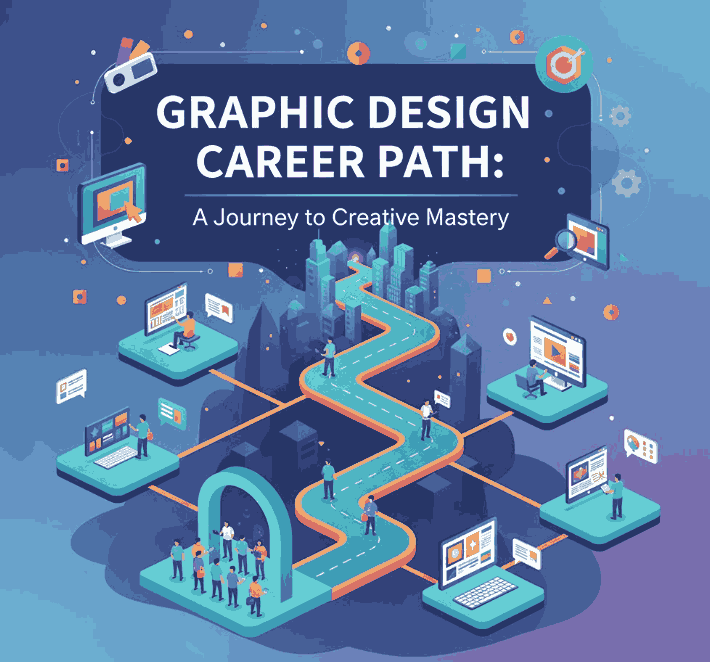Table of Contents
- Introduction
- What Is a Graphic Design Career Path?
- Essential Skills Every Graphic Designer Needs
- Popular Career Specializations in Graphic Design
- Tools and Software You Must Master
- How to Build a Strong Design Portfolio
- Choosing the Right Fonts for Professional Design Work
- Recommended Font Mockups from Edric Studio
- Tips to Advance Your Graphic Design Career
- Conclusion
- References
1. Introduction
The graphic design industry continues to grow rapidly, offering countless opportunities for creative individuals who want to turn visual artistry into a long-term career. From branding and digital marketing to UI/UX and motion graphics, the graphic design career path is more diverse and exciting than ever.
If you are planning to start a career as a graphic designer—or want to refine your current direction—this guide will help you understand the skills, tools, portfolio building strategies, and industry expectations you need to succeed.

2. What Is a Graphic Design Career Path?
A graphic design career path is the journey a designer takes as they develop their skills, specialize in certain areas, and build a professional portfolio. It typically starts with learning design fundamentals, mastering software tools, exploring niche specializations, and eventually positioning yourself as a freelancer, agency designer, or creative entrepreneur.
Whether you dream of becoming a branding expert, a UI designer, or even a font creator, the design world is full of opportunities.
3. Essential Skills Every Graphic Design Career Path Needs
To grow in the design field, you must master both technical and creative skills:
Creative Skills
- Typography mastery
- Visual hierarchy
- Color theory
- Layout and composition
- Storytelling in visual form
Technical Skills
- Proficiency in design software
- Understanding file formats and export settings
- Knowledge of responsive and digital design
- Ability to prepare design files for printing
Soft Skills
- Communication
- Project management
- Problem-solving
- Collaboration and adaptability
These skills form the foundation of a successful graphic design career.
4. Popular Career Specializations in Graphic Design Career Path
Graphic design is not a single job—it’s a wide field with multiple career paths. Here are the most in-demand specializations:
Brand Identity Graphic Design Career Path
Focuses on creating logos, brand guidelines, and visual identities.
UI/UX Graphic Design Career Path
Creates intuitive interfaces for websites, mobile apps, and digital products.
Motion Graphic Design Career Path
Works on animated graphics, intros, ads, and video content.
Typography & Font Graphic Design Career Path
Designs custom fonts, lettering, and typography systems—one of the fastest-growing creative niches.
Marketing & Social Media Graphic Design Career Path
Creates visual content for digital ads, social media campaigns, and marketing materials.
Print & Packaging Graphic Design Career Path
Designs brochures, packaging, posters, business cards, and more.
Each specialization offers different income potential and creative freedom depending on your interests.
5. Tools and Software You Must Master
To succeed in most graphic design roles, these tools are essential:
- Adobe Photoshop – Photo editing & composite design
- Adobe Illustrator – Vector graphics & logo creation
- Adobe InDesign – Layouts and print design
- Figma – UI/UX design and prototyping
- Procreate – Hand-drawn illustrations
- Blender / Cinema4D – Optional for 3D & motion design
You don’t need to master them all immediately—start with the basics and build up gradually.

6. How to Build a Strong Graphic Design Career Path Portfolio
Your portfolio is your most powerful asset in the creative industry. Focus on:
- Showcasing your best 6–10 works
- Creating case studies with explanations
- Demonstrating your design process
- Using consistent branding across your portfolio
- Highlighting your specialization clearly
A well-polished portfolio can drastically increase your chances of getting clients, job offers, or freelance projects.
7. Choosing the Right Fonts for Professional Graphic Design Career Path Work
Typography plays a huge role in design. High-quality fonts help designers create:
- Strong brand identities
- Memorable logos
- Professional marketing materials
- Modern UI designs
This is why many designers and agencies rely on premium fonts like those from Edric Studio, which are crafted for branding, editorial, marketing, and digital design.
8. Recommended Font Mockups from Edric Studio
Here are curated fonts from EdricStudio.com that you can showcase in your article and link to:
1. COET Sans Serif Font
A clean, elegant sans serif perfect for branding and editorial layouts.
2. ALDORA Futuristic Font
A modern, futuristic font ideal for digital, tech, and UI-related designs.
3. Roundfra Modern Sans Serif Font
Soft, rounded geometry suitable for modern product branding and lifestyle design.
4. Myron Hector Sans Serif Font
Professional, versatile, and polished—great for portfolio projects and corporate branding.
These examples help reinforce how typography supports the growth of a designer’s career path.
9. Tips to Advance Your Graphic Design Career Path
To move forward in your design career:
✔ Keep Learning
The industry evolves fast—stay updated with trends and new tools.
✔ Build Your Network
Connect with other designers, join communities, and attend creative events.
✔ Create Personal Projects
They can strengthen your portfolio and attract clients organically.
✔ Learn Business Skills
Freelancers especially need pricing, negotiation, and client management skills.
✔ Specialize Over Time
Having a niche makes you more valuable and easier to market.
10. Conclusion
The graphic design career path is filled with exciting opportunities, whether you’re aiming to become a brand designer, UI specialist, or even a font creator. With the right skills, tools, portfolio, and creative mindset, you can build a successful and sustainable design career.
And as typography is a core part of design, using premium typefaces—such as those crafted by Edric Studio—can elevate your work and help you stand out in the competitive creative industry.
11. References
- Interaction — What is Graphic Design?
- AIGA — Official Graphic Design Resources
- JustTheSkills — How to Become a Graphic Designer

